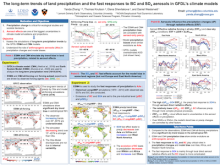The long-term trends of global land precipitation and the fast responses to black carbon and sulfate aerosols in the GFDL ESM4 climate model
Yanda
Zhang
Lamont‐Doherty Earth Observatory of Columbia University
Poster
Aerosol effects on precipitation are crucial factors in climate change, yet they remain poorly understood, representing a large source of uncertainty in climate models. In the GFDL Earth System Model 4 (ESM4), simulated historical century-scale trends of global land precipitation demonstrate significant dry biases compared to observations, even with observed historical variations of sea surface temperature and sea ice concentrations (LongAMIP simulation). The biases manifest as overestimated decreasing precipitation trends over tropical-subtropical land and underestimated increases in higher latitudes. In this study, we investigate the “fast response” of precipitation to historical anthropogenic aerosol emissions and its contributions to the model trend biases, by conducting idealized ESM4 LongAMIP experiments with emissions of either black carbon (BC) sulfate (SO4) aerosol precursors set to near-pre-industrial levels (1850). Aerosol direct radiative effects emerge as critical drivers of excessive precipitation declines in some regions: (1) over East Asia, the overestimated negative effect of the SO4 on historical precipitation contributes to the model bias in this region in large part. (2) For Northwest Tropical Africa, negative fast responses to SO4 and BC contribute to the overestimated 20th-century precipitation decline. (3) Over west-central North America, the negative fast response to BC in the model contributes toward underestimating a modest observed increasing precipitation trend. However, over eastern North America and Northwest Eurasia, the fast responses of precipitation to aerosols cannot account for the opposite direction of model bias, indicating the dominant influence of other factors.

Poster file
zhang-yanda-confronting-poster.pdf
(1.88 MB)
